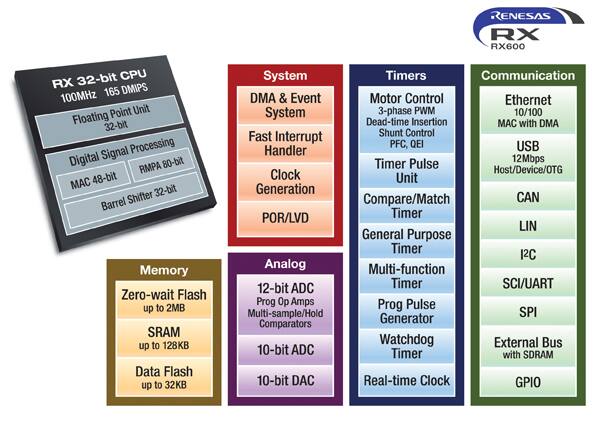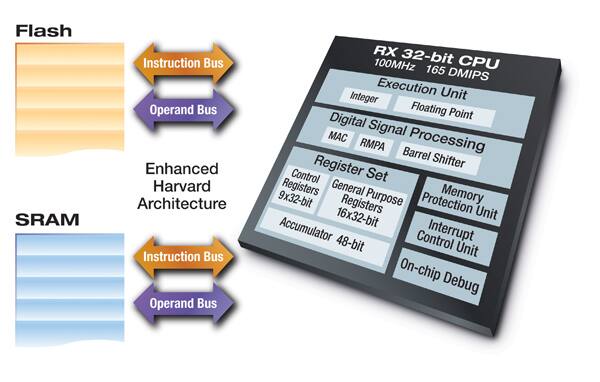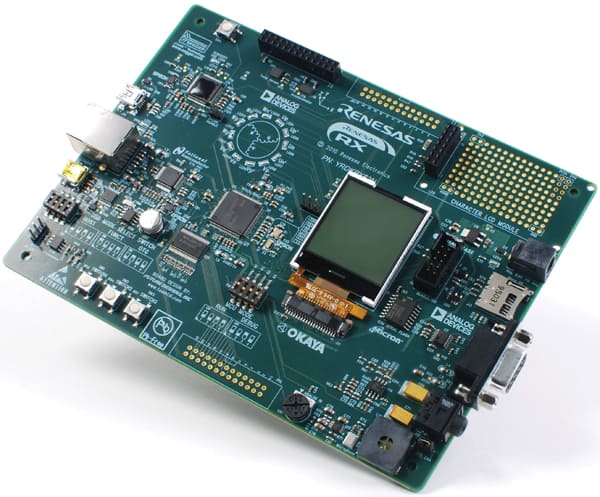Introducing the RX600
投稿人:Convergence Promotions LLC
2011-01-11
Renesas' new RX600 series is a MCU/DSP hybrid, or Digital Signal Controller (DSC), running embedded 100MHz Flash to produce 165 Dhrystone MIPS when running at 100 MHz as an MCU. This is not your grandfather's MCU.
Combining best-in-class MCU features with powerful DSP capabilities, the RX600 is a Digital Signal Controller (DSC) that delivers on the promise of true Single-Chip Enablement.
Today, we are surrounded by complex real-world analog and digital signals. Be it sound, vibration, temperature, voltage, or even high-speed streaming digital data such as Ethernet, USB, CAN and others, embedded developers are faced with the need to interpret these complex signals, process them, and then efficiently generate precision analog and digital outputs in real-time for audio, motor and motion control, power conditioning, animated graphics, and streaming digital data. Traditionally this problem was solved with a multi-chip solution. Now there is another option.
The new RX600 series from Renesas is an MCU/DSP hybrid, or Digital Signal Controller (DSC). Built around the revolutionary new RX CPU core, the RX600 leverages the industry's only embedded 100MHz Flash to produce 165 Dhrystone MIPS when running at 100 MHz as an MCU. It's also a very powerful signal processor because of its Enhanced Harvard Architecture and integrated Floating Point Unit (FPU) and Multiple-Accumulate (MAC) unit.


The RX600 draws on the efficient RX instruction set, supported by 10 rich addressing modes, to enable up to 28 percent code size savings over competing architectures. Built on a low-power platform that uses low-power design techniques such as clock gating, power gating, and multi VT transistors, the RX600 is an extremely power-efficient device drawing only 1mW per DMIPS in active mode with all peripherals running.
Spanning Flash sizes from 64 kB up to 2 MB and available in packages having 64 to 176 pins, the RX600 is a scalable series offering 200+ devices from which to choose. The RX600 groups are true System-on-a-Chip (SOC) solutions that integrate a wide range of industry leading peripherals. For example, the RX62T group includes Advanced Motor Control timers and Advanced Analog to Digital Converter subsystems with Programmable Gain Amplifiers, Window Comparators, and Multi-Sample Hold circuits, enabling the RX62T to drive two three-phase motors at the same time using minimal additional external components. Other groups that are currently available include the RX610, RX621, and RX62N which includes Ethernet, two USB ports, and CAN and is ideal for applications with heavy communication needs.
How do you get started with RX? It's easy. The RX RDK board (part number YRDKRX62N) is available at DigiKey. This Renesas Demo Kit contains an RX62N device with integrated 512kB Flash, Ethernet, CAN, and USB connectivity. The RDK board includes a built-in Segger J-Link debugger and is surrounded by a rich set of partner devices enabling capabilities such as microSD Socket, 128MB PCM Serial Flash, temperature sensor, 3-axis digital accelerometer, 96x64 LCD, speaker, microphone, and more. The kit also includes an evaluation version of Renesas' High-Performance Embedded Workshop (HEW) and lots of example code to help the user get up and running quickly.


免责声明:各个作者和/或论坛参与者在本网站发表的观点、看法和意见不代表 DigiKey 的观点、看法和意见,也不代表 DigiKey 官方政策。







 中国
中国